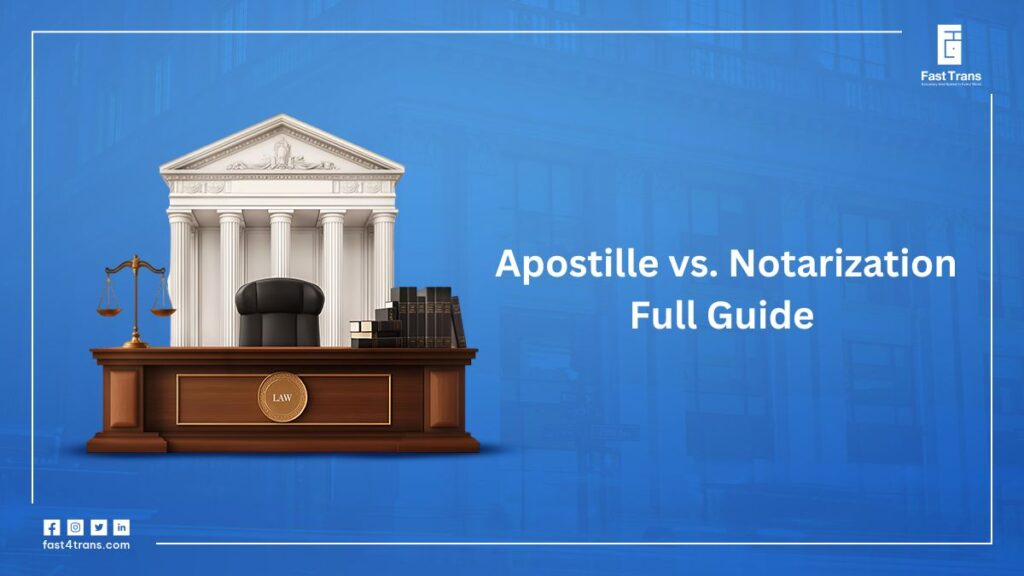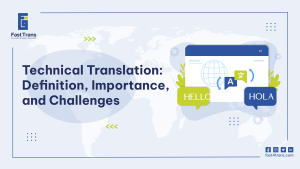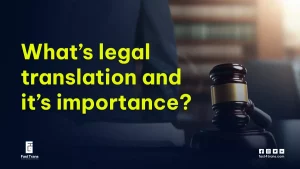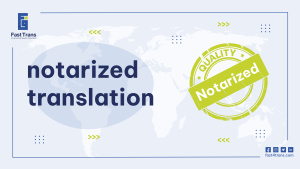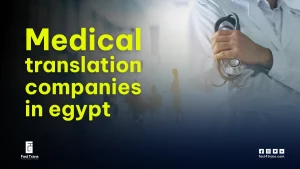Official documents play a crucial role in our personal, legal, and business lives. From birth certificates and marriage licenses to contracts and academic records, these documents serve as proof of identity, agreements, or qualifications. Ensuring their authenticity is essential to avoid disputes, legal complications, or delays in important processes.
However, navigating the requirements for document authentication can be confusing. Many people face the dilemma of what types of translation their documents need, a notarization or an apostille. While both processes verify authenticity, they serve different purposes and are used in different contexts. Understanding the distinction between the two is key to ensuring that your documents are recognized and accepted, whether at home or abroad.
What is Notarization?
Notarization translation is the official process by which a notary public certifies the authenticity of signatures on a document, confirming that the signer is who they claim to be and that they signed the document willingly.
The primary purpose of notarization is to prevent fraud and ensure the integrity of important documents. By having a document notarized, parties involved can trust that the signatures are genuine and that the document holds legal weight.
Typical documents that often require notarization include:
- Contracts and agreements between individuals or businesses
- Affidavits and sworn statements
- Powers of attorney
- Property deeds and mortgage documents
Notarization is widely used for documents that need legal recognition within the same country, ensuring that the document is trustworthy and enforceable in domestic matters.
What is an Apostille?
An apostille is an official certification that verifies the authenticity of a public document for use in another country. Unlike notarization, which primarily serves domestic purposes, an apostille ensures that a document will be legally recognized abroad.
The main purpose of an apostille is to facilitate international document acceptance by confirming that the signatures, seals, or stamps on the document are genuine and issued by a competent authority. This process is especially important for legal, business, and personal documents that need to be presented in foreign countries, such as birth certificates, marriage licenses, academic transcripts, or corporate documents.
The key difference between domestic notarization and apostille certification is that notarization validates a document within the issuing country, while an apostille extends that validation to other countries that are part of an international agreement. Essentially, an apostille acts as a bridge for documents to cross borders without losing legal credibility.
Currently, more than 120 countries participate in the Hague Apostille Convention, including:
- United States
- United Kingdom
- Canada
- Australia
- France
- Germany
- Japan
- India
This international recognition simplifies legal and administrative processes, ensuring that documents are accepted without requiring additional legalization by embassies or consulates.
Key Differences Between Notarization and Apostille
Understanding the differences between notarization and apostille is essential to ensure your documents are properly authenticated. Here’s a breakdown of the key distinctions:
| Aspect | Notarization | Apostille |
| Legal Scope | Valid primarily within the issuing country. | Recognized internationally in countries that are part of the Hague Apostille Convention. |
| Authority | Performed by a notary public, a legally authorized individual. | Issued by a government authority, such as the Secretary of State or the Ministry of Foreign Affairs. |
| Process & Timeline | Involves visiting a notary, verifying identity, signing in their presence, and receiving the notarized document. Usually completed the same day or within a few days. | Requires submitting the notarized document to the appropriate government office for certification. Processing can take several days to weeks, depending on the country. |
| Cost | Typically low to moderate, depending on the notary and document type. | Usually higher, as it may involve multiple steps, including notarization, government certification, and sometimes mailing fees. |
By understanding these differences, you can ensure that your documents meet the correct legal requirements for domestic or international use, avoiding delays or rejection.
When Do You Need a Notarization vs. an Apostille?
Knowing whether to get a notarization or an apostille depends on where and how the document will be used.
Domestic Use – Notarization is Sufficient
If your documents are intended for use within your own country, a notarization is usually all that’s required. This ensures that signatures are verified, and the document is legally recognized for domestic purposes. Examples include:
- Signing contracts between local parties
- Filing affidavits with local courts
- Granting powers of attorney for domestic transactions
International Use – Apostille is Required
If your documents will be used in a foreign country, an apostille is typically necessary. The apostille certifies the authenticity of the document so that it is legally recognized abroad, particularly in countries that are part of the Hague Apostille Convention. Common scenarios include:
- Sending birth or marriage certificates abroad for immigration or family matters
- Legalizing a business contract internationally for cross-border transactions
- Submitting academic records or diplomas for studying or working overseas
By understanding these requirements, you can avoid delays, extra costs, or legal issues that may arise from submitting improperly certified documents.
How to Get a Notarization?
Getting a notarization is usually straightforward, but following the proper steps ensures your document is legally valid. Here’s how to do it:
1. Prepare Your Document
Before visiting a notary, ensure that your document is complete and contains all the required information. Double-check for any missing fields, dates, or signatures that might cause delays. Importantly, do not sign the document beforehand, as the notary must witness your signature to validate its authenticity.
2. Find a Licensed Notary Public
Locate a licensed notary in your area, who can often be found at banks, law offices, government offices, or through private notary services. It’s crucial to verify that the notary is officially licensed in your jurisdiction, as only authorized notaries can provide legally recognized certifications.
3. Bring Valid Identification
Bring a government-issued ID, such as a passport, driver’s license, or national ID card. The notary will use this identification to verify your identity, ensuring that the signature on the document belongs to the correct individual. This step is essential to prevent fraud and maintain the document’s legal integrity.
4. Sign the Document in the Notary’s Presence
Sign the document only when the notary is present. In some cases, the notary may also ask you to take an oath or make a sworn statement, depending on the type of document. This ensures that the signing process is legitimate and legally binding.
5. Receive the Notarized Document
Once the document is signed, the notary will apply their official seal or stamp and provide their signature, certifying the document’s authenticity. Keep the notarized document safe, as it serves as a trusted legal verification for domestic use and may be required for future legal, business, or personal transactions.
Step-by-Step Guide: How to Get an Apostille
Obtaining an apostille can seem complex at first, but breaking it down into clear steps makes the process manageable. Here’s how to do it:
1. Prepare Your Document
Before requesting an apostille, make sure your document is complete, accurate, and properly notarized if required. Some documents must be notarized before they can be apostilled, so verify the specific requirements for your document type. Having a clean, error-free document will help prevent delays or rejections.
2. Identify the Competent Authority
An apostille must be issued by the designated government authority in your country, such as the Secretary of State, Ministry of Foreign Affairs, or another authorized office. Check official resources to confirm which office handles apostilles for your document type and location.
3. Submit Your Document for Certification
Take your notarized or original document to the appropriate authority. Depending on the country, you may submit it in person, by mail, or through an online application if available. Include any required forms, identification, or fees to ensure your submission is complete.
4. Pay Applicable Fees
Apostille services usually involve a fee, which can vary depending on the type of document and processing speed. Some offices offer expedited services for an additional cost. Make sure to check the payment methods accepted by the issuing authority, such as credit card, bank transfer, or cash.
5. Receive the Apostilled Document
Once processed, the authority will attach an apostille certificate or stamp to your document, verifying its authenticity for international use. The apostilled document is now legally recognized in countries that are part of the Hague Apostille Convention, allowing you to use it abroad without additional legalization.
Top Mistakes to Avoid When Getting Documents Notarized or Apostilled
Navigating the processes of notarization and apostille can be tricky, and these common mistakes often cause unnecessary frustration.
1. Confusing notarization with apostille
One of the most frequent errors is assuming that a notarized document is automatically valid for international use. Notarization only verifies authenticity within your country, while an apostille is required for recognition abroad. Mixing the two can lead to rejected documents or delays in legal or administrative processes.
2. Submitting improperly certified documents abroad
Sending documents that are missing notarization, an apostille, or other required certifications can cause major setbacks. Many institutions will refuse to accept incomplete documents, forcing you to redo the process and pay additional fees. Always double-check that your documents meet the required certification standards.
3. Not checking the destination country’s requirements
Each country may have specific rules regarding document acceptance, even if it is part of the Hague Apostille Convention. Failing to verify these requirements can result in rejected submissions, extra processing steps, or additional legalization requirements. Researching the destination country’s guidelines in advance can save time, money, and frustration.
Read Also: Sworn Translation In The UAE?
Simplify Your Document Certification with Fast Trans
Navigating notarization and apostille requirements can be time-consuming and confusing. That’s where Fast Trans comes in. With years of experience in handling official document certifications, Fast Trans offers a reliable, fast, and hassle-free service for both domestic and international needs. Whether you need documents notarized locally or apostilled for use abroad, Fast Trans ensures every step is completed accurately and efficiently.
Contact us via our official website
What Our Customers Say
Since the translation project is theirs, we encourage the clients to discuss every stage of the process.
You can check our clients’ comments for yourself at Google Reviews.
Conclusion
Understanding the difference between notarization and apostille is essential for ensuring that your documents are legally recognized, whether domestically or internationally. While notarization validates documents for use within your own country, an apostille certifies them for foreign recognition, helping you avoid delays, legal issues, or rejected submissions.
By carefully following the proper steps and avoiding common mistakes, you can ensure that your documents are processed smoothly and accepted wherever they are needed. Services like Fast Trans make this process even easier, providing expert guidance and reliable support for both notarization and apostille, saving you time and giving you peace of mind.

